|
|

|
|
Author
|
Topic: Hubble Telescope anniversaries and milestones
|
Robert Pearlman
Editor Posts: 42988
From: Houston, TX
Registered: Nov 1999
|
 posted 04-25-2005 04:28 PM
posted 04-25-2005 04:28 PM
   
NASA release Hubble celebrates 15th anniversary with new imagesDuring the 15 years NASA's Hubble Space Telescope has orbited the Earth, it has taken more than 750,000 photos of the cosmos; images that have awed, astounded and even confounded astronomers and the public. NASA released new views today of two of the most well-known objects Hubble has ever observed: the Eagle Nebula and the Whirlpool Galaxy (spiral galaxy M51). These new images are among the largest and sharpest Hubble has ever taken. They were made with Hubble's newest camera, the Advanced Camera for Surveys (ACS). The images are so incredibly sharp, they could be enlarged to billboard size and still retain stunning details. 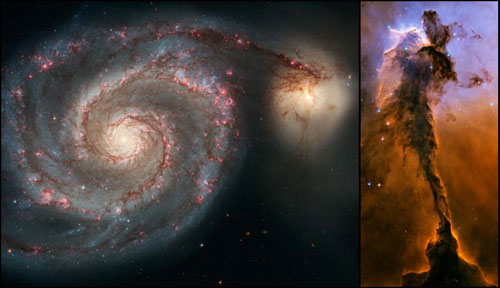 For the 15th anniversary, scientists used the ACS to record a new region of the eerie-looking Eagle Nebula. The Eagle Nebula image reveals a tall, dense tower of gas being sculpted by ultraviolet light from a group of massive, hot stars. The new Whirlpool Galaxy image showcases the spiral galaxy's classic features, from its curving arms, where newborn stars reside, to its yellowish central core that serves as home for older stars. A feature of considerable interest is the companion galaxy located at the end of one of the spiral arms. The mural-sized celestial images of the Eagle Nebula and Whirlpool Galaxy were unveiled today at the Smithsonian's National Air and Space Museum in Washington. More than 100 museums, planetariums, and science centers will also unveil these same images today. The Space Shuttle Discovery placed the Hubble into Earth orbit on April 25, 1990, opening a new era in astronomy. For the first time, a large telescope that viewed in visible light orbited above Earth's distorting atmosphere, which blurs light, making images appear fuzzy. After installation of a new camera and a device that compensated for an improperly ground mirror, images of planets, stars, galaxies, and nebula began pouring in - most up to 10 times sharper than delivered by any previous telescope. Hubble has compiled a long list of scientific achievements since its launch. Hubble has: - Helped astronomers calculate the precise age of the universe (13.7 billion years old)
- Helped confirm the existence of a strange form of energy called dark energy
- Detected small proto-galaxies that emitted their light when the universe was less than a billion years old
- Proved the existence of super-massive black holes
- Provided sharp views of a comet hitting Jupiter
- Showed the process of forming planetary systems is common throughout the galaxy
The Space Telescope Science Institute (STScI) manages Hubble imagery. It is operated for NASA by the Association of Universities for Research in Astronomy, Inc. under contract with NASA's Goddard Space Flight Center, Greenbelt, Md. The Hubble Space Telescope is an international cooperative activity between NASA and the European Space Agency. For a list of the museums and other locations displaying the new 4-by-6-foot image of the Whirlpool Galaxy and the 3-by-6-foot image of the Eagle Nebula, visit the Space Telescope Science Institute. Electronic image files and additional 15th anniversary information are available at HubbleSite. |
Robert Pearlman
Editor Posts: 42988
From: Houston, TX
Registered: Nov 1999
|
 posted 04-24-2007 01:25 PM
posted 04-24-2007 01:25 PM
   
Space Telescope Science Institute release The Carina Nebula: Star Birth in the ExtremeIn celebration of the 17th anniversary of the launch and deployment of NASA's Hubble Space Telescope, a team of astronomers is releasing one of the largest panoramic images ever taken with Hubble's cameras. It is a 50-light-year-wide view of the central region of the Carina Nebula where a maelstrom of star birth - and death - is taking place. Hubble's view of the nebula shows star birth in a new level of detail. The fantasy-like landscape of the nebula is sculpted by the action of outflowing winds and scorching ultraviolet radiation from the monster stars that inhabit this inferno. In the process, these stars are shredding the surrounding material that is the last vestige of the giant cloud from which the stars were born. 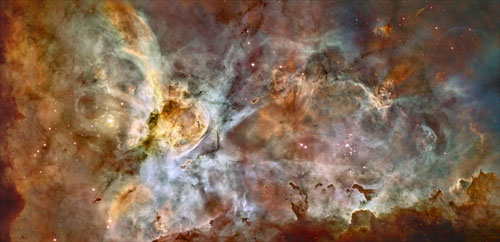 The immense nebula contains at least a dozen brilliant stars that are roughly estimated to be at least 50 to 100 times the mass of our Sun. The most unique and opulent inhabitant is the star Eta Carinae, at far left. Eta Carinae is in the final stages of its brief and eruptive lifespan, as evidenced by two billowing lobes of gas and dust that presage its upcoming explosion as a titanic supernova. The fireworks in the Carina region started three million years ago when the nebula's first generation of newborn stars condensed and ignited in the middle of a huge cloud of cold molecular hydrogen. Radiation from these stars carved out an expanding bubble of hot gas. The island-like clumps of dark clouds scattered across the nebula are nodules of dust and gas that are resisting being eaten away by photoionization. The hurricane blast of stellar winds and blistering ultraviolet radiation within the cavity is now compressing the surrounding walls of cold hydrogen. This is triggering a second stage of new star formation. Our Sun and our solar system may have been born inside such a cosmic crucible 4.6 billion years ago. In looking at the Carina Nebula we are seeing the genesis of star making as it commonly occurs along the dense spiral arms of a galaxy. The immense nebula is an estimated 7,500 light-years away in the southern constellation Carina the Keel (of the old southern constellation Argo Navis, the ship of Jason and the Argonauts, from Greek mythology). This image is a mosaic of the Carina Nebula assembled from 48 frames taken with Hubble Space Telescope's Advanced Camera for Surveys. The Hubble images were taken in the light of neutral hydrogen. Color information was added with data taken at the Cerro Tololo Inter-American Observatory in Chile. Red corresponds to sulfur, green to hydrogen, and blue to oxygen emission. To download larger versions of this image and/or for more information, see:
The Carina Nebula: Star Birth in the Extreme |
Robert Pearlman
Editor Posts: 42988
From: Houston, TX
Registered: Nov 1999
|
 posted 04-24-2008 11:49 AM
posted 04-24-2008 11:49 AM
   
Space Telescope Science Institute release Galaxies Gone Wild!Astronomy textbooks typically present galaxies as staid, solitary, and majestic island worlds of glittering stars. But galaxies have a wild side. They have flirtatious close encounters that sometimes end in grand mergers and overflowing "maternity wards" of new star birth as the colliding galaxies morph into wondrous new shapes. Today, in celebration of the Hubble Space Telescope's 18th launch anniversary, 59 views of colliding galaxies constitute the largest collection of Hubble images ever released to the public. This new Hubble atlas dramatically illustrates how galaxy collisions produce a remarkable variety of intricate structures in never-before-seen detail. 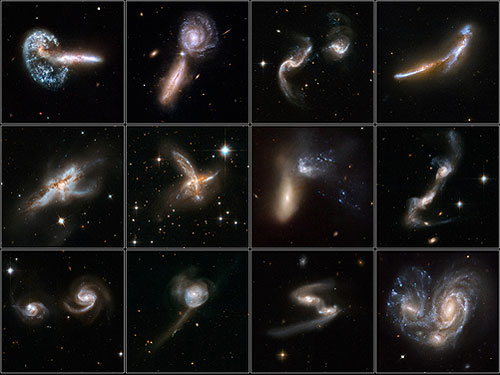 Astronomers observe only one out of a million galaxies in the nearby universe in the act of colliding. However, galaxy mergers were much more common long ago when they were closer together, because the expanding universe was smaller. Astronomers study how gravity choreographs their motions in the game of celestial bumper cars and try to observe them in action. For all their violence, galactic smash-ups take place at a glacial rate by human standards - timescales on the order of several hundred million years. The images in the Hubble atlas capture snapshots of the various merging galaxies at various stages in their collision. Most of the 59 new Hubble images are part of a large investigation of luminous and ultra- luminous infrared galaxies called the GOALS project (Great Observatories All-sky LIRG Survey). This survey combines observations from Hubble, NASA's Spitzer Space Telescope, NASA's Chandra X-ray Observatory, and NASA's Galaxy Evolution Explorer. The majority of the Hubble observations are led by Aaron S. Evans of the University of Virginia, Charlottesville, the National Radio Astronomy Observatory, and Stony Brook University. |
Robert Pearlman
Editor Posts: 42988
From: Houston, TX
Registered: Nov 1999
|
 posted 08-11-2008 10:36 AM
posted 08-11-2008 10:36 AM
   
Space Telescope Science Institute release Hubble Unveils Colorful and Turbulent Star-Birth Region on 100,000th Orbit MilestoneIn commemoration of NASA's Hubble Space Telescope completing its 100,000th orbit in its 18th year of exploration and discovery, scientists at the Space Telescope Science Institute in Baltimore, Md., have aimed Hubble to take a snapshot of a dazzling region of celestial birth and renewal. Hubble peered into a small portion of the nebula near the star cluster NGC 2074 (upper, left). 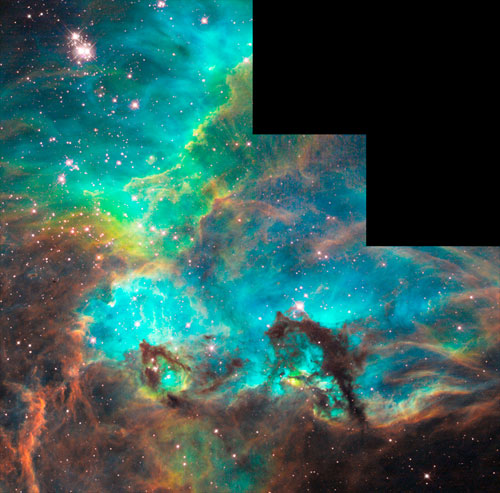 The region is a firestorm of raw stellar creation, perhaps triggered by a nearby supernova explosion. It lies about 170,000 light-years away near the Tarantula nebula, one of the most active star-forming regions in our Local Group of galaxies. This representative color image was taken on August 10, 2008, with Hubble's Wide Field Planetary Camera 2. Red shows emission from sulfur atoms, green from glowing hydrogen, and blue from glowing oxygen. To mark Hubble's 100,000th orbit, the Space Telescope Science Institute (STScI) will award 18 randomly-chosen entrants with a 16 by 20-inch photograph of this image. To enter the raffle, see the STScI's HubbleSite before the drawing on August 18, 2008.
|
Robert Pearlman
Editor Posts: 42988
From: Houston, TX
Registered: Nov 1999
|
 posted 04-24-2010 01:51 PM
posted 04-24-2010 01:51 PM
   
NASA release NASA's Starry-Eyed Hubble Telescope Celebrates 20 Years of Discovery As the Hubble Space Telescope achieves the major milestone of two decades on orbit, NASA and the Space Telescope Science Institute (STScI) in Baltimore are celebrating Hubble's journey of exploration with a stunning new picture and several online educational activities. There are also opportunities for the public to explore galaxies as armchair scientists and send personal greetings to Hubble. NASA is releasing a new Hubble photo of a small portion of one of the largest known star-birth regions in the galaxy, the Carina Nebula. Three light-year-tall towers of cool hydrogen laced with dust rise from the wall of the nebula. The scene is reminiscent of Hubble's classic "Pillars of Creation" photo from 1995, but even more striking. 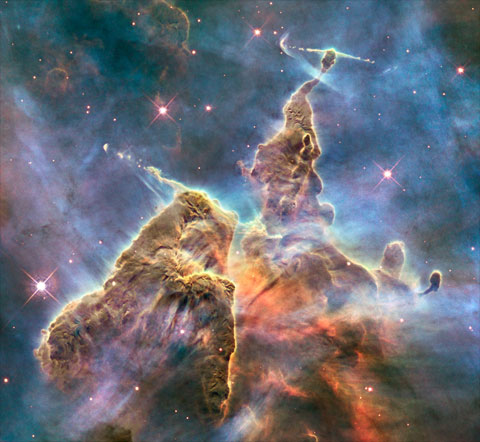 NASA's best-recognized, longest-lived and most prolific observatory was launched April 24, 1990, onboard the space shuttle Discovery's STS-31 mission. Hubble discoveries revolutionized nearly all areas of current astronomical research from planetary science to cosmology. Over the years, Hubble suffered broken equipment, a bleary-eyed primary mirror, and the cancellation of a planned shuttle servicing mission. But the ingenuity and dedication of scientists, engineers and NASA astronauts allowed the observatory to rebound and thrive. The telescope's crisp vision continues to challenge scientists and the public with new discoveries and evocative images. "Hubble is undoubtedly one of the most recognized and successful scientific projects in history," said Ed Weiler, associate administrator for the Science Mission Directorate at NASA Headquarters. "Last year's space shuttle servicing mission left the observatory operating at peak capacity, giving it a new beginning for scientific achievements that impact our society." Hubble fans worldwide are being invited to take an interactive journey with Hubble. They can also visit HubbleSite.org to share the ways the telescope has affected them. Follow the "Messages to Hubble" link to send an e-mail, post a Facebook message, or send a cell phone text message. Fan messages will be stored in the Hubble data archive along with the telescope's science data. For those who use Twitter, you can follow @HubbleTelescope or post tweets using the Twitter hashtag #hst20. The public also will have an opportunity to become at-home scientists by helping astronomers sort out the thousands of galaxies seen in a Hubble deep field observation. STScI is partnering with the Galaxy Zoo consortium of scientists to launch an Internet-based astronomy project where amateur astronomers can peruse and sort galaxies from Hubble's deepest view of the universe into their classic shapes: spiral, elliptical, and irregular. Dividing the galaxies into categories will allow astronomers to study how they relate to each other and provide clues that might help scientists understand how they formed. For educators and students, STScI is creating an educational website called "Celebrating Hubble's 20th Anniversary." It offers links to facts and trivia about Hubble, a story that chronicles the observatory's life and discoveries, and the IMAX "Hubble 3D" educator's guide. An anniversary poster with Hubble's "hall-of-fame" images, including the Eagle Nebula and Saturn, also is being offered with downloadable classroom activity information. To date, Hubble has observed more than 30,000 celestial targets and amassed more than a half-million pictures in its archive. The last servicing mission to Hubble in May 2009 made the telescope 100 times more powerful than when it was launched. |
Robert Pearlman
Editor Posts: 42988
From: Houston, TX
Registered: Nov 1999
|
 posted 04-24-2010 02:55 PM
posted 04-24-2010 02:55 PM
   
Google Doodle for April 24, 2010: Take a tour of the universe with Hubble imagery in Google Earth. |
Robert Pearlman
Editor Posts: 42988
From: Houston, TX
Registered: Nov 1999
|
 posted 04-20-2011 09:38 AM
posted 04-20-2011 09:38 AM
   
NASA release NASA's Hubble Celebrates 21st Anniversary With "Rose" Of GalaxiesTo celebrate the 21st anniversary of the Hubble Space Telescope's deployment into space, astronomers at the Space Telescope Science Institute in Baltimore pointed Hubble's eye at an especially photogenic pair of interacting galaxies called Arp 273. 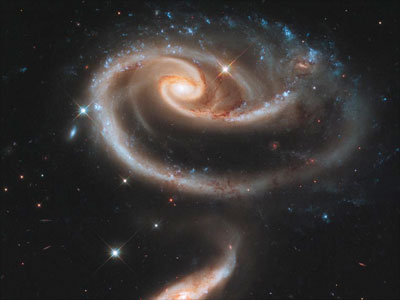
Credit: NASA, ESA, and the Hubble Heritage Team (STScI/AURA)"For 21 years, Hubble has profoundly changed our view of the universe, allowing us to see deep into the past while opening our eyes to the majesty and wonders around us," NASA Administrator Charles Bolden said."I was privileged to pilot space shuttle Discovery as it deployed Hubble. After all this time, new Hubble images still inspire awe and are a testament to the extraordinary work of the many people behind the world's most famous observatory." Hubble was launched April 24, 1990, aboard Discovery's STS-31 mission. Hubble discoveries revolutionized nearly all areas of current astronomical research from planetary science to cosmology. "Hubble is America's gift to the world," Sen. Barbara Mikulski of Maryland said. "Its jaw-dropping images have rewritten the textbooks and inspired generations of schoolchildren to study math and science. It has been documenting the history of our universe for 21 years. Thanks to the daring of our brave astronauts, a successful servicing mission in 2009 gave Hubble new life. I look forward to Hubble's amazing images and inspiring discoveries for years to come." The newly released Hubble image shows a large spiral galaxy, known as UGC 1810, with a disk that is distorted into a rose-like shape by the gravitational tidal pull of the companion galaxy below it, known as UGC 1813. A swath of blue jewel-like points across the top is the combined light from clusters of intensely bright and hot young blue stars. These massive stars glow fiercely in ultraviolet light. The smaller, nearly edge-on companion shows distinct signs of intense star formation at its nucleus, perhaps triggered by the encounter with the companion galaxy. Arp 273 lies in the constellation Andromeda and is roughly 300 million light-years away from Earth. The image shows a tenuous tidal bridge of material between the two galaxies that are separated from each other by tens of thousands of light-years. A series of uncommon spiral patterns in the large galaxy are a tell-tale sign of interaction. The large, outer arm appears partially as a ring, a feature seen when interacting galaxies actually pass through one another. This suggests the smaller companion dived deep, but off-center, through UGC 1810. The inner set of spiral arms is highly warped out of the plane, with one of the arms going behind the bulge and coming back out the other side. How these two spiral patterns connect is not precisely known. The larger galaxy in the UGC 1810 - UGC 1813 pair has a mass about five times that of the smaller galaxy. In unequal pairs such as this, the relatively rapid passage of a companion galaxy produces the lopsided or asymmetric structure in the main spiral. Also in such encounters, the starburst activity typically begins in the minor galaxies earlier than in the major galaxies. These effects could be because the smaller galaxies have consumed less of the gas present in their nuclei, from which new stars are born. The interaction was imaged on Dec. 17, 2010, with Hubble's Wide Field Camera 3 (WFC3). The picture is a composite of data taken with three separate filters on WFC3 that allow a broad range of wavelengths covering the ultraviolet, blue, and red portions of the spectrum. The Hubble Space Telescope is a project of international cooperation between NASA and the European Space Agency. NASA's Goddard Space Flight Center manages the telescope. The Space Telescope Science Institute (STScI) conducts Hubble science operations. STScI is operated for NASA by the Association of Universities for Research in Astronomy Inc. in Washington. |
Robert Pearlman
Editor Posts: 42988
From: Houston, TX
Registered: Nov 1999
|
 posted 07-05-2011 05:42 PM
posted 07-05-2011 05:42 PM
   
NASA release NASA's Hubble Makes One Millionth Science ObservationNASA's Hubble Space Telescope crossed another milestone in its space odyssey of exploration and discovery. On Monday, July 4, the Earth-orbiting observatory logged its one millionth science observation during a search for water in an exoplanet's atmosphere 1,000 light-years away. "For 21 years Hubble has been the premier space science observatory, astounding us with deeply beautiful imagery and enabling ground-breaking science across a wide spectrum of astronomical disciplines," said NASA Administrator Charles Bolden. He piloted the space shuttle mission that carried Hubble to orbit. "The fact that Hubble met this milestone while studying a faraway planet is a remarkable reminder of its strength and legacy." Although Hubble is best known for its stunning imagery of the cosmos, the millionth observation is a spectroscopic measurement, where light is divided into its component colors. These color patterns can reveal the chemical composition of cosmic sources. Hubble's millionth exposure is of the planet HAT-P-7b, a gas giant planet larger than Jupiter orbiting a star hotter than our sun. HAT-P-7b, also known as Kepler 2b, has been studied by NASA's planet-hunting Kepler observatory after it was discovered by ground-based observations. Hubble now is being used to analyze the chemical composition of the planet's atmosphere. "We are looking for the spectral signature of water vapor. This is an extremely precise observation and it will take months of analysis before we have an answer," said Drake Deming of the University of Maryland and NASA's Goddard Space Flight Center in Greenbelt, Md. "Hubble demonstrated it is ideally suited for characterizing the atmospheres of exoplanets, and we are excited to see what this latest targeted world will reveal." Hubble was launched April 24, 1990, aboard space shuttle's Discovery's STS-31 mission. Its discoveries revolutionized nearly all areas of astronomical research from planetary science to cosmology. The observatory has collected more than 50 terabytes of data to-date. The archive of that data is available to scientists and the public. Hubble's odometer reading includes every observation of astronomical targets since its launch and observations used to calibrate its suite of instruments. Hubble made the millionth observation using its Wide Field Camera 3, a visible and infrared light imager with an on-board spectrometer. It was installed by astronauts during the Hubble Servicing Mission 4 in May 2009. "The Hubble keeps amazing us with groundbreaking science," said Sen. Barbara A. Mikulski, the chairwoman of the Senate Commerce, Justice, Science and Related Agencies Appropriations Subcommittee that funds NASA. "I championed the mission to repair and renew Hubble not just to get one million science observations, but also to inspire millions of children across the planet to become our next generation of stargazers, scientists, astronauts and engineers." Hubble is a project of international cooperation between NASA and the European Space Agency. Goddard manages the telescope. The Space Telescope Science Institute (STScI) conducts Hubble science operations. STScI is operated for NASA by the Association of Universities for Research in Astronomy Inc. in Washington. |
Robert Pearlman
Editor Posts: 42988
From: Houston, TX
Registered: Nov 1999
|
 posted 03-17-2014 10:27 AM
posted 03-17-2014 10:27 AM
   
NASA release Hubble Celebrates 24th Anniversary with Infrared Image of Nearby Star FactoryIn celebration of the 24th anniversary of the launch of NASA's Hubble Space Telescope, astronomers have captured infrared-light images of a churning region of star birth 6,400 light-years away. The collection of images reveals a shadowy, dense knot of gas and dust sharply contrasted against a backdrop of brilliant glowing gas in the Monkey Head Nebula (also known as NGC 2174 and Sharpless Sh2-252). 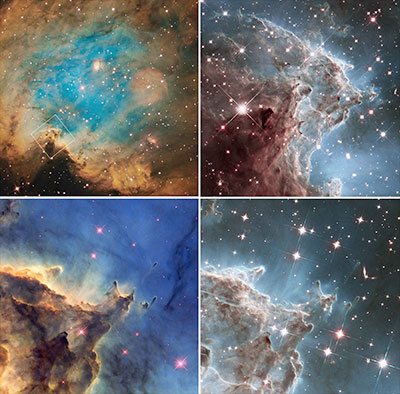 The image demonstrates Hubble's powerful infrared vision and offers a tantalizing hint of what scientists can expect from the upcoming James Webb Space Telescope. Observations of NGC 2174 were taken in February, 2014. Massive newborn stars near the center of the nebula (and toward the right in this image) are blasting away at dust within the nebula. The ultraviolet light emitted by these bright stars helps shape the dust into giant pillars. This carving action occurs because the nebula is mostly composed of hydrogen gas, which becomes ionized by the ultraviolet radiation. As the dust particles are warmed by the ultraviolet light of the stars, they heat up and begin to glow at infrared wavelengths. The Hubble Space Telescope is a project of international cooperation between NASA and the European Space Agency. NASA's Goddard Space Flight Center in Greenbelt, Md., manages the telescope. The Space Telescope Science Institute (STScI) in Baltimore conducts Hubble science operations. STScI is operated for NASA by the Association of Universities for Research in Astronomy, Inc., in Washington. |
Robert Pearlman
Editor Posts: 42988
From: Houston, TX
Registered: Nov 1999
|
 posted 04-19-2018 10:17 AM
posted 04-19-2018 10:17 AM
   
Space Telescope Science Institute (STScI) release Hubble 28th Anniversary Image Captures Roiling Heart of Vast Stellar NurseryThis colorful image, taken by NASA's Hubble Space Telescope, celebrates the Earth-orbiting observatory's 28th anniversary of viewing the heavens, giving us a window seat to the universe's extraordinary tapestry of stellar birth and destruction.  At the center of the photo, a monster young star 200,000 times brighter than our Sun is blasting powerful ultraviolet radiation and hurricane-like stellar winds, carving out a fantasy landscape of ridges, cavities, and mountains of gas and dust. This mayhem is all happening at the heart of the Lagoon Nebula, a vast stellar nursery located 4,000 light-years away and visible in binoculars simply as a smudge of light with a bright core. The giant star, called Herschel 36, is bursting out of its natal cocoon of material, unleashing blistering radiation and torrential stellar winds (streams of subatomic particles) that push dust away in curtain-like sheets. This action resembles the Sun bursting through the clouds at the end of an afternoon thunderstorm that showers sheets of rainfall. Herschel 36's violent activity has blasted holes in the bubble-shaped cloud, allowing astronomers to study this action-packed stellar breeding ground. The hefty star is 32 times more massive and 40,000 times hotter than our Sun. It is nearly nine times our Sun's diameter. Herschel 36 is still very active because it is young by a star's standards, only 1 million years old. Based on its mass, it will live for another 5 million years. In comparison, our smaller Sun is 5 billion years old and will live another 5 billion years. This region epitomizes a typical, raucous stellar nursery full of birth and destruction. The clouds may look majestic and peaceful, but they are in a constant state of flux from the star's torrent of searing radiation and high-speed particles from stellar winds. As the monster star throws off its natal cocoon of material with its powerful energy, it is suppressing star formation around it. However, at the dark edges of this dynamic bubble-shaped ecosystem, stars are forming within dense clouds of gas and dust. Dark, elephant-like "trunks" of material represent dense pieces of the cocoon that are resistant to erosion by the searing ultraviolet light and serve as incubators for fledgling stars. They are analogous to desert buttes that resist weather erosion. The Hubble view shows off the bubble's 3D structure. Dust pushed away from the star reveals the glowing oxygen gas (in blue) behind the blown-out cavity. Herschel 36's brilliant light is illuminating the top of the cavity (in yellow). The reddish hue that dominates part of the region is glowing nitrogen. The dark purple areas represent a mixture of hydrogen, oxygen, and nitrogen. The image shows a region of the nebula measuring about 4 light-years across. The observations were taken by Hubble's Wide Field Camera 3 between Feb. 12 and Feb. 18, 2018. | |
Contact Us | The Source for Space History & Artifacts
Copyright 2020 collectSPACE.com All rights reserved.

Ultimate Bulletin Board 5.47a
|
|

|
 advertisement advertisement

|




















